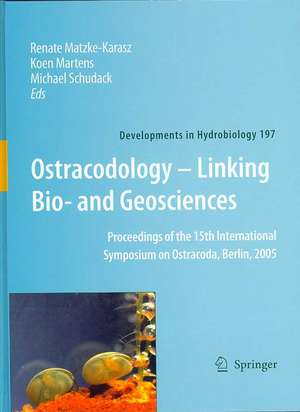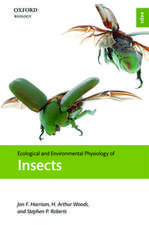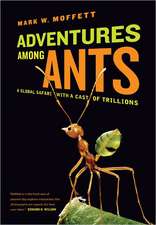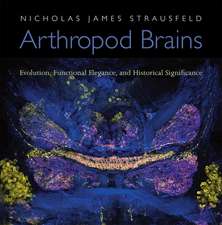Ostracodology - Linking Bio- and Geosciences: Proceedings of the 15th International Symposium on Ostracoda, Berlin, 2005: Developments in Hydrobiology, cartea 197
Editat de Renate Matzke-Karasz, Koen Martens, Michael Schudacken Limba Engleză Hardback – 20 iul 2007
The diversity of ostracod applications in both biology and palaeontology is clearly illustrated by the eighteen papers of the 15th International Symposium on Ostracoda (Berlin, Germany) in 2005, which are grouped in the present proceedings, one of three volumes resulting from this meeting.
| Toate formatele și edițiile | Preț | Express |
|---|---|---|
| Paperback (1) | 1044.84 lei 38-45 zile | |
| SPRINGER NETHERLANDS – 23 noi 2010 | 1044.84 lei 38-45 zile | |
| Hardback (1) | 1061.39 lei 38-45 zile | |
| SPRINGER NETHERLANDS – 20 iul 2007 | 1061.39 lei 38-45 zile |
Din seria Developments in Hydrobiology
- 18%
 Preț: 1229.10 lei
Preț: 1229.10 lei - 18%
 Preț: 959.98 lei
Preț: 959.98 lei - 18%
 Preț: 963.91 lei
Preț: 963.91 lei - 15%
 Preț: 648.24 lei
Preț: 648.24 lei - 15%
 Preț: 637.89 lei
Preț: 637.89 lei -
 Preț: 378.23 lei
Preț: 378.23 lei - 15%
 Preț: 644.95 lei
Preț: 644.95 lei - 18%
 Preț: 952.09 lei
Preț: 952.09 lei - 20%
 Preț: 558.87 lei
Preț: 558.87 lei - 18%
 Preț: 1833.65 lei
Preț: 1833.65 lei -
 Preț: 393.59 lei
Preț: 393.59 lei -
 Preț: 406.54 lei
Preț: 406.54 lei - 18%
 Preț: 1226.73 lei
Preț: 1226.73 lei - 18%
 Preț: 956.99 lei
Preț: 956.99 lei -
 Preț: 388.87 lei
Preț: 388.87 lei - 24%
 Preț: 1060.51 lei
Preț: 1060.51 lei - 18%
 Preț: 1229.28 lei
Preț: 1229.28 lei - 20%
 Preț: 569.30 lei
Preț: 569.30 lei -
 Preț: 368.79 lei
Preț: 368.79 lei - 24%
 Preț: 817.46 lei
Preț: 817.46 lei - 18%
 Preț: 958.25 lei
Preț: 958.25 lei - 18%
 Preț: 953.03 lei
Preț: 953.03 lei -
 Preț: 384.75 lei
Preț: 384.75 lei - 24%
 Preț: 1582.91 lei
Preț: 1582.91 lei - 24%
 Preț: 1051.68 lei
Preț: 1051.68 lei - 18%
 Preț: 943.57 lei
Preț: 943.57 lei - 18%
 Preț: 1235.76 lei
Preț: 1235.76 lei - 24%
 Preț: 800.02 lei
Preț: 800.02 lei - 24%
 Preț: 803.55 lei
Preț: 803.55 lei - 18%
 Preț: 948.29 lei
Preț: 948.29 lei
Preț: 1061.39 lei
Preț vechi: 1396.57 lei
-24% Nou
Puncte Express: 1592
Preț estimativ în valută:
203.09€ • 212.05$ • 168.09£
203.09€ • 212.05$ • 168.09£
Carte tipărită la comandă
Livrare economică 31 martie-07 aprilie
Preluare comenzi: 021 569.72.76
Specificații
ISBN-13: 9781402064173
ISBN-10: 1402064179
Pagini: 280
Ilustrații: VI, 272 p.
Dimensiuni: 193 x 260 x 17 mm
Greutate: 0.84 kg
Ediția:2007
Editura: SPRINGER NETHERLANDS
Colecția Springer
Seria Developments in Hydrobiology
Locul publicării:Dordrecht, Netherlands
ISBN-10: 1402064179
Pagini: 280
Ilustrații: VI, 272 p.
Dimensiuni: 193 x 260 x 17 mm
Greutate: 0.84 kg
Ediția:2007
Editura: SPRINGER NETHERLANDS
Colecția Springer
Seria Developments in Hydrobiology
Locul publicării:Dordrecht, Netherlands
Public țintă
ResearchCuprins
Ostracodology in time and space: looking back on fifteen International Symposia on Ostracoda, and the times in between.- Ostracodology in time and space: looking back on fifteen International Symposia on Ostracoda, and the times in between.- Review Paper.- Ostracod recovery in the aftermath of the Permian-Triassic crisis: Palaeozoic-Mesozoic turnover.- Ostracod Taxonomy and Biogeography.- The influence of El Ninñ 1997–98 on pelagic ostracods in the Humboldt Current Ecosystem off Peru.- A new, interstitial species of Terrestricythere (Crustacea: Ostracoda) and its microdistribution at Orito Beach, northeastern Sea of Japan.- Non-marine Ostracoda (Crustacea) of Banat district in Serbia.- Ecological Factors Affecting Ostracod Distribution.- A year round comparative study on the population structures of pelagic Ostracoda in Admiralty Bay (Southern Ocean).- Water quality and diversity of the Recent ostracod fauna in lowland springs from Lombardy (northern Italy).- Factors affecting spatial and temporal distribution of Ostracoda assemblages in different macrophyte habitats of a shallow lake (Lake Fehér, Hungary).- Groundwater Ostracods from the arid Pilbara region of northwestern Australia: distribution and water chemistry.- Ecological requirements of Ostracoda (Crustacea) in a heavily polluted shallow lake, Lake Yeniça?a (Bolu, Turkey).- Food selection in Eucypris virens (Crustacea: Ostracoda) under experimental conditions.- Evolutionary Significance of Ostracod Morphology.- Extra-lobal and complex dimorphic features in Middle Devonian palaeocopine ostracods.- Evolutionary and taxonomic aspects within the species group Pseudocandona eremita (Vejdovský) (Ostracoda, Candonidae).- On the origin of the putative furca of the Ostracoda (Crustacea).- Ultrastructure of thecarapace margin in the Ostracoda (Arthropoda: Crustacea).- Ultrastructure of hepatopancreas and its possible role as a hematopoietic organ in non-marine cypridoidean ostracods (Crustacea).- Copulatory behaviour and sexual morphology of three Fabaeformiscandona Krsti?, 1972 (Candoninae, Ostracoda, Crustacea) species from Japan, including descriptions of two new species.- Early release of eggs and embryos in a brooding ancient asexual ostracod: brood selection or a gambling strategy to increase fecundity?.- The ontogeny of appendages of Heterocypris salina (Brady, 1868) Ostracoda (Crustacea).
Textul de pe ultima copertă
Ostracods, small aquatic Crustacea, occur in almost every marine, brackish and freshwater habitat. Their calcified bivalved carapaces readily fossilize and their record in earth history is long, dense and diverse. Ostracod species are particularly useful as tools in marine and limnic (palaeo-) ecology, in (palaeo-) biogeography, and biostratigraphy. Their reproductive morphology is as extraordinary as their reproductive modes, and many of their physiological peculiarities remain mysterious. Ostracod taxonomy and phylogeny contribute to general studies of crustacean evolution.
The diversity of ostracod applications in both biology and palaeontology is clearly illustrated by the eighteen papers of the 15th International Symposium on Ostracoda (Berlin, Germany) in 2005, which are grouped in the present proceedings, one of three volumes resulting from this meeting.
The diversity of ostracod applications in both biology and palaeontology is clearly illustrated by the eighteen papers of the 15th International Symposium on Ostracoda (Berlin, Germany) in 2005, which are grouped in the present proceedings, one of three volumes resulting from this meeting.
Caracteristici
Comprehensive update of ongoing research in Ostracod sciences Illustrations of ostracods as model groups in various research areas (evolutionary biology of reproductive modes, palaeoecology related to climate change and global warming, ...) Test cases of pathways of arthropod evolution, with special reference to crustacean comparative morphology













